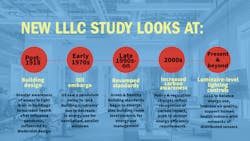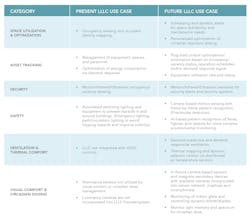The University of Oregon’s Energy Studies in Building Lab has published research titled “Luminaire Level Lighting Controls and the Future of Healthy Buildings,” in conjunction with the BetterBricks initiative funded by the Northwest Energy Efficiency Alliance, that concludes advising the commercial building sector to adopt luminaire-level lighting controls (LLLC). The research states that LLLC both maximize the energy savings opportunity of solid-state lighting (SSL) while also providing the infrastructure needed for healthier buildings. Moreover, the LLLC implementation provides the backbone for applications including optimization of space in buildings, indoor wayfinding, and integration with other building systems.
The authors of the published paper are Kevin Van Den Wymelenberg, PhD; Alen Mahic; and Paul Ward. The paper begins with an acknowledgment that commercial building practices and systems are influenced by global societal events such as the 1918 influenza pandemic that sparked the Modernism movement simultaneously with the recognition of the need for better lighting and air quality in commercial spaces. The oil shortage of the early to mid-70s, meanwhile, swung the pendulum to a primary focus on energy efficiency.
Of course, the COVID-19 pandemic has refocused the attention of building owners and facility managers on air quality just as the lighting for health and wellbeing movement was gaining traction to support employee productivity and circadian health. The new whitepaper espouses a commercial building concept that:
- Rapidly reduces building energy consumption and helps reduce climate change
- Improves indoor air quality and helps reduce airborne transmission of pathogens
- Improves the overall indoor environment to boost the human immune function
The University of Oregon and BetterBricks are not the first organizations or people to advocate for LLLC. Indeed, we published details on a Northwest Energy Efficiency Alliance (NEEA) report earlier this year that projected the cost of LLLC at various levels of integration and that argued for adoption of what the study authors called fully smart implementations. That NEEA report said costs for fully smart systems will decrease dramatically as interoperability among disparate systems improves and installation becomes simpler.
Still, it is good to get more academic input on the LLLC prospects. Moreover, the Oregon research sought to specifically study the case for LLLC implementations in retrofit applications. The document essentially stipulates that LLLC is a sure winner in any commercial new build applications. In retrofit applications, building owners and facility managers face the difficult choice of replacing existing luminaires or doing a complete renovation of a building, most often one floor at a time. That scenario essentially becomes a new-build project. The Oregon researchers studied in detail LLLC implementations based on a one-for-one retrofit of existing luminaires in a building.
The Oregon research distinguishes between the LLLC concept and what you often hear called NLC (networked lighting controls) scenarios. The whitepaper seems to equate NLC with the full-retrofit scenario. We are not sure that is fair treatment. In either the one-for-one retrofit or complete-renovation scenarios, stakeholders could face the choice of simple room-level controls that handle autonomous sensor-based dimming or NLC technology that adds programmatic controls and integration with other building systems and the Internet of Things (IoT).
The new whitepaper explains that even with one-for-one installations, Bluetooth- or Wi-Fi-based sensors and controls could deliver the network backbone required for smart buildings. It seems perhaps as if the authors considered that NLC systems might implement sensor networks that are even more granular than in the LLLC case where there is one sensor per luminaire. We’d argue that luminaire-level granularity is suitable for most applications.
The authors say the big win for LLLC comes in a much lower upfront cost. The report states that LLLC projects cost 30% of what a full renovation would cost. And the authors argue that LLLC projects can deliver light quality improvements matching those of full renovation. We’d note that such quality comparisons will depend on the specific application at hand and should be studied individually.
The latter two thirds of the new whitepaper dig deep into the applications that are possible with a networked lighting infrastructure. The research does not cover any significant new ground beyond what we have published previously in a range of staff and contributed articles. For example, just a month ago we published details on an indoor positioning project undertaken by Fagerhult and Sony. And we have written regularly on the benefits of real estate space optimization.
The BetterBricks and University of Oregon whitepaper does provide compelling detail on the challenges and benefits of connected SSL in the following scenarios:
- Space utilization and optimization
- Asset tracking
- Security
- Safety
- Ventilation and thermal comfort
- Visual comfort and circadian dosing
Learn more about the findings of the researchers by accessing the full whitepaper.
LEDs Magazine chief editor MAURY WRIGHT is an electronics engineer turned technology journalist, who has focused specifically on the LED & Lighting industry for the past decade.
*Updated June 15, 2021 9:41 AM for table inclusion.
*Updated June 16, 2021 1:10 PM for name correction.
For up-to-the-minute LED and SSL updates, why not follow us on Twitter? You’ll find curated content and commentary, as well as information on industry events, webcasts, and surveys on our LinkedIn Company Page and our Facebook page.






